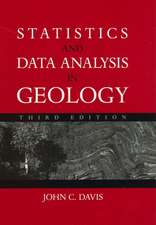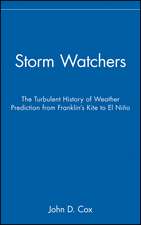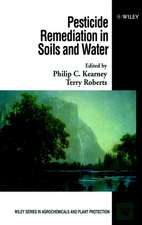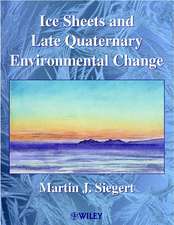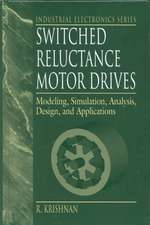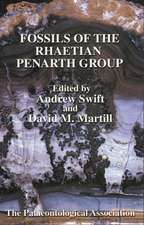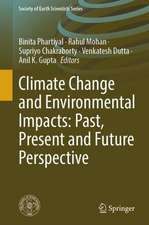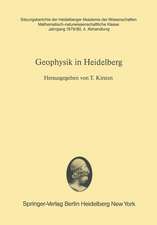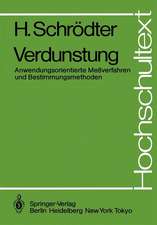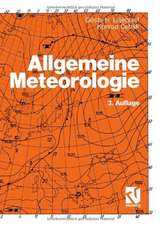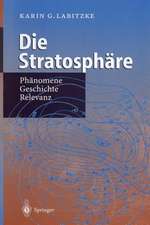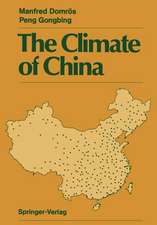Assessment of Climate Change over the Indian Region: A Report of the Ministry of Earth Sciences (MoES), Government of India
Editat de R. Krishnan, J. Sanjay, Chellappan Gnanaseelan, Milind Mujumdar, Ashwini Kulkarni, Supriyo Chakrabortyen Limba Engleză Hardback – 13 iun 2020
| Toate formatele și edițiile | Preț | Express |
|---|---|---|
| Paperback (1) | 361.66 lei 6-8 săpt. | |
| Springer Nature Singapore – 18 sep 2020 | 361.66 lei 6-8 săpt. | |
| Hardback (1) | 400.03 lei 38-44 zile | |
| Springer Nature Singapore – 13 iun 2020 | 400.03 lei 38-44 zile |
Preț: 400.03 lei
Nou
Puncte Express: 600
Preț estimativ în valută:
76.54€ • 80.13$ • 63.34£
76.54€ • 80.13$ • 63.34£
Carte tipărită la comandă
Livrare economică 01-07 aprilie
Preluare comenzi: 021 569.72.76
Specificații
ISBN-13: 9789811543265
ISBN-10: 9811543267
Pagini: 226
Ilustrații: XXI, 226 p. 89 illus., 85 illus. in color.
Dimensiuni: 210 x 279 mm
Greutate: 0.82 kg
Ediția:1st ed. 2020
Editura: Springer Nature Singapore
Colecția Springer
Locul publicării:Singapore, Singapore
ISBN-10: 9811543267
Pagini: 226
Ilustrații: XXI, 226 p. 89 illus., 85 illus. in color.
Dimensiuni: 210 x 279 mm
Greutate: 0.82 kg
Ediția:1st ed. 2020
Editura: Springer Nature Singapore
Colecția Springer
Locul publicării:Singapore, Singapore
Cuprins
Chapter-1: Introduction.- Chapter 2: Temperature Changes in India.- Chapter-3: Precipitation Changes in India.- Chapter-4: Observations and modeling of GHG concentrations and fluxes over India.- Chapter-5: Aerosols & Atmospheric Trace Gases.- Chapter-6: Droughts and Floods.- Chapter-7: Synoptic Scale Systems.- Chapter-8. Extreme Storms.- Chapter-9: Sea Level Rise.- Chapter-10: Indian Ocean Warming.- Chapter-11: Climate Change over the Himalayas.
Notă biografică
R. Krishnan specializes in climate modelling studies on scientific issues relating to the “dynamics, variability, and predictability of the Asian monsoon, climate change and impacts on monsoon precipitation extremes, phenomenon of monsoon breaks and droughts”. Currently, he is leading the Centre for Climate Change Research (CCCR) at the Indian Institute of Tropical Meteorology, Pune, and is involved in developing in-house capability in Earth System Modeling to address various scientific issues related to climate change and monsoon. He carried out Ph.D. research in Atmospheric Sciences at the Physical Research Laboratory, Ahmedabad, and obtained Ph.D. degree from the University of Pune in 1994. He has published more than 100 scientific articles/papers, advised Ph.D.s (11 awarded, 12 ongoing) as supervisor/co-supervisor and 6 Master (M.Sc/M.Tech) dissertations, and offered training lectures in Geophysical Fluid Dynamics & Atmospheric Science. He is a fellow of the Indian Academy ofScience (IASc), Indian National Science Academy (INSA), and the Indian Meteorological Society (IMS). He is a Member of the Joint Scientific Committee (JSC) of the World Climate Research Programme (WCRP), Coordinating Lead Author (CLA) of the Chapter on Water Cycle Changes in the IPCC WG1 Sixth Assessment Report (AR6), and CLA of the Chapter on Climate Change in the Hindu Kush Himalayan (HKH) Monitoring and Assessment Programme (HIMAP). He has also served as a Member of the CLIVAR Monsoon Panel and the CORDEX Science Advisory Team of the WCRP, WMO. He is an Editor for the scientific journals—Earth System Dynamics (EGU Journal), Mausam (IMD Journal), and Journal of Indian Society of Remote Sensing.
J. Sanjay specializes in the area of regional climate change with a focus on the generation of future climate change scenarios for the Indian monsoon region using dynamical downscaling techniques with high resolution regional climate models (RCMs). He is leading the CCCR team for coordinating the data archiving, management, and dissemination activities of the South Asia component of the international coordinated Regional Climate Downscaling Experiment (CORDEX) initiative by the World Climate Research Program (WCRP) of WMO. Prior to joining IITM in 1988, Sanjay completed M.Sc. in Meteorology at the Cochin University of Science and Technology. He carried out Ph.D. research in Atmospheric Sciences at IITM and obtained Ph.D. degree from the University of Pune in 2007. He has 40 publications, including 21 papers in peer-reviewed journals. Sanjay is a Member of the WCRP CORDEX Science Advisory Team (SAT), a Contributing Author (CA) of the IPCC Working Group I (WGI) Sixth Assessment Report Chapter Atlas, and a Lead Author (LA) of the Chapter on Climate Change in the Hindu Kush Himalayan (HKH) Monitoring and Assessment Programme (HIMAP). He was also a scientific knowledge partner on climate science for a segment of the International CARIAA research programme on climate change Adaptation at Scale in Semi-Arid Regions (ASSAR) of India.
Chellappan Gnanaseelan is a Senior Scientist and Project Director of Short Term Climate Variability and Prediction, at the Indian Institute of Tropical Meteorology (IITM), Pune. He received his Ph.D. and M.Tech. degrees from the Indian Institute of Technology (IIT), Kharagpur, India. He also served as visiting fellow at Florida State University. His research interests include climate variability, Indian Ocean dynamics and variability, annual to decadal climate prediction and variability, ocean modelling, air–sea interaction, monsoon variability and teleconnection, and data assimilation. He has authored over 100 research papers in peer-reviewed journals. He has successfully guided 15 Ph.D. and 30 Master’s students and presently guiding many doctoral and postdoctoral students and also contributed considerably to human resource development by teaching Master’s and Ph.D. students atPune University, IITM, University of Hyderabad, IIT Bhubaneswar, and IIT Delhi and trainees of India Meteorological Department. He is an Associate Editor of Journal of Earth System Science and Editor of Ocean Digest, the quarterly newsletter of Ocean Society of India. He is also an Adjunct Professor of Pune University.
Dr. Milind Mujumdar is a Senior Scientist at the Centre for Climate Change Research (CCCR), Indian Institute of Tropical Meteorology (IITM), Pune. He is currently engaged in the field scale soil moisture monitoring using Cosmos Ray Soil-Moisture Monitoring System (COSMOS) and wireless network of various surface hydro-meteorological sensors to study the soil water dynamics. He has carried out diagnostic and modelling studies to understand the Asian monsoon variability and its response to warming climate. He completed his education up to M.Sc. (Mathematics) from Khandwa (M.P.). He obtained his M.Phil. with focus on “Mathematical Modelling” during1989 and Ph.D. on studies related to “Climate Modelling” during 2002, from the University of Pune. He has published more than 30 research articles in national and international journals. He is also associated with Universities and Institutes for guiding M.Sc./M.Tech. and Ph.D. students. During his research career, he had scientific visits to the University of Tokyo, Hokkaido University, Nagoya University Japan; University of Hawaii, USA; University of Reading and European Centre for Medium Range Weather Forecast (ECMWF), UK; CSIRO (Melbourne, Australia); University of Cape Town (South Africa).
Ashwini Kulkarni has a Ph.D. in Statistics (1992) from the Pune University. She has 30 years of research experience in the field of Atmospheric Science. Her main research interests include climate variations and eleconnections over South, East, and Southeast Asia; Asian monsoon variability in coupled and regional climate model simulations and projections; applications ofstatistics in climate research. She has published more than 50 research papers in reviewed scientific international journals. She received the 10th IITM Silver Jubilee award for best research contribution in 1997, and she is “Adjunct Professor” of Department of Atmospheric and Space Science, Savitribai Phule Pune University since 2000. She has been providing guidance to Ph.D., M.Tech./M.Sc. students for their thesis/projects and has a vital contribution into human resource development of IITM, IMD, and SPPU. She is a member of international committees, viz. Empirical Statistical Downscaling Group-Asia and Upper Indus Basin Network. She is also a Senior Scientist at International CLIVAR Monsoon Project Office at IITM. She is a contributory author of Chapter 14 of IPCC AR5 and Reviewer of IPCC special reports.
Supriyo Chakraborty, Scientist-F, is presently Head of the Mass Spectrometry Group and the MetFlux India Project that investigates the atmosphere–biosphere exchanges of CO2 and energy fluxes at various ecosystems across the country. He obtained his B.Sc. (Hons) from the Indian Institute of Technology, Kharagpur, in 1984, and M.Sc. in Exploration Geophysics from the same institute in 1986. He worked as a graduate student at the Physical Research Laboratory, Ahmedabad, and obtained his Ph.D. in 1995 of M.S. University of Baroda. He undertook postdoctoral work at the University of California, Santa Barbara, during 1995-1996 and also at the University of California, San Diego, during 1996-1998. Afterwards, he worked at the Physical Research Laboratory, Ahmedabad, and Birbal Sahni Institute of Paleosciences, Lucknow, and currently at IITM since 2007. He has been working in the fields of monsoon reconstruction using the isotopic analysis of natural archives, stable isotopic characteristics of precipitation and study of moisture dynamical processes, ecosystem GHGs fluxes, and energy transfer processes at various natural ecosystems. He hasbeen recognized as an Adjunct Professor, at the Savitribai Phule Pune University, Pune. He has supervised/co-supervised several students for Ph.D. and M.Sc. dissertation. He has published over 60 research papers in various national and international journals.
Textul de pe ultima copertă
This open access book discusses the impact of human-induced global climate change on the Indian subcontinent and regional monsoon, the adjoining Indian Ocean and the Himalayas. It also examines the regional climate change projections based on the climate models used by the IPCC Fifth Assessment Report (AR5) and national climate change modeling studies using the IITM Earth System Model (ESM) and CORDEX South Asia datasets. The IPCC assessment reports, published every 6–7 years, provide important reference material for major policy decisions on climate change, adaptation, and mitigation. While the IPCC assessment reports largely provide a global perspective on climate change, they offer limited information on the regional aspects of climate change. Regional climate change effects over the Indian subcontinent, especially relating to the Indian monsoon, are unique to the region, and in particular, the climate in this region is shaped by the Himalayas, Western Ghats, the Tibetan Plateau, the Indian Ocean, Arabian Sea, and Bay of Bengal. Climatic variations in this region are influenced by (a) regional-scale interactions between the atmosphere, ocean, land surface, cryosphere and biosphere on different time scales, (b) remote effects from natural phenomena such as the El Nino / Southern Oscillation, North Atlantic Oscillation, Indian Ocean Dipole, and Madden Julian Oscillation, and (c) human-induced climate change. This book presents policy-relevant information based on robust scientific analysis and assessments of the observed and projected future climate change over the Indian region.
Caracteristici
Discusses the influence of human-induced global climate change on the Indian subcontinent Presents a synthesis of historical and future projected changes in the global and regional climate over the India subcontinent - based on scientific literature, observations, climate model projections and published IPCC reports Serves as a reference resource for researchers, practitioners in academia and industry, and policymakers



